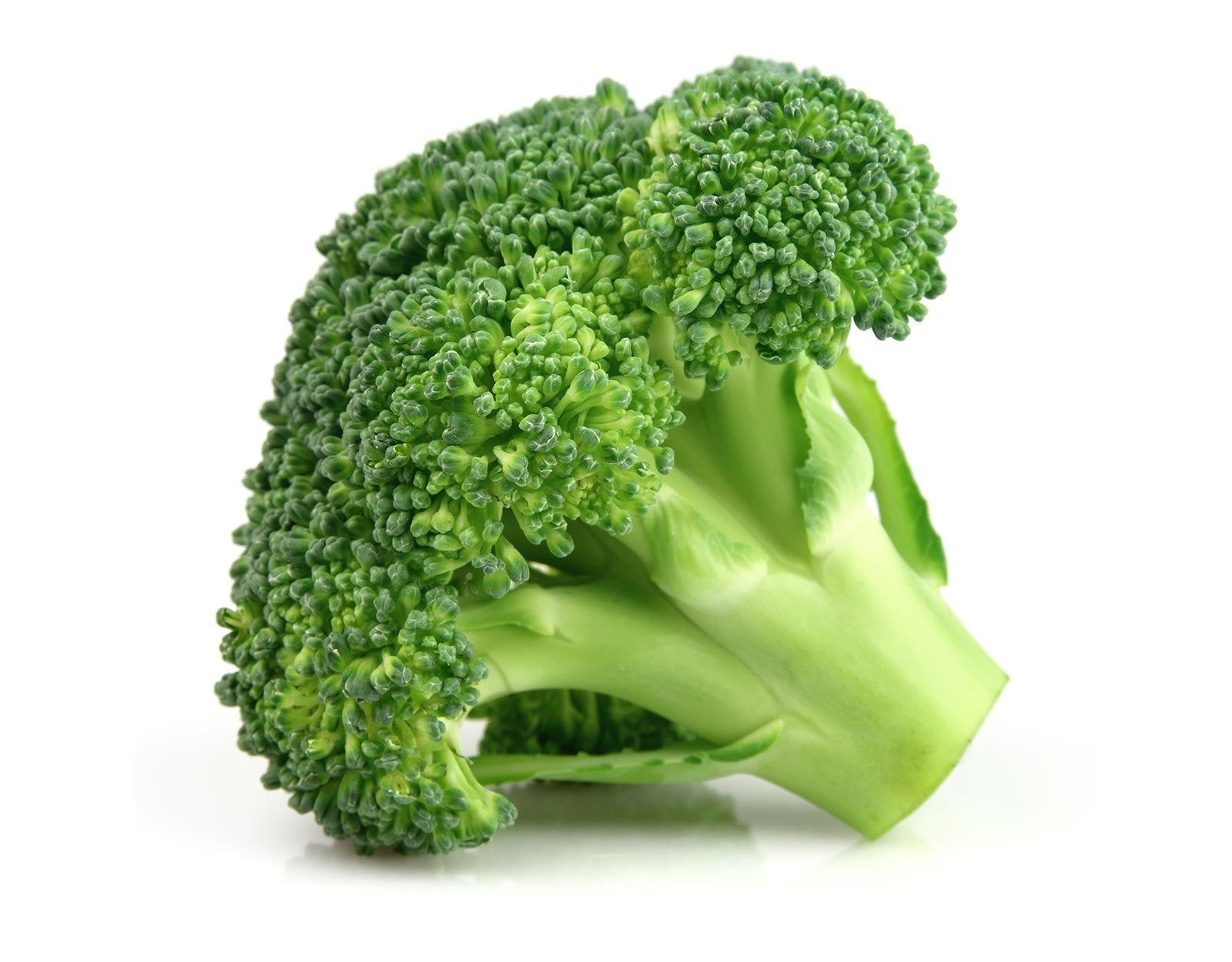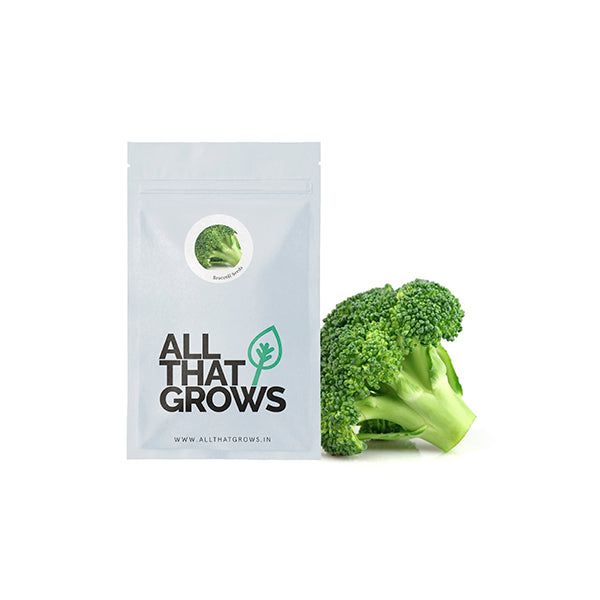



- SOWING
TIMEAugust - October
- Sowing
DistancePlant to Plant - 1'
Line to Line - 1.5' - Fruit
WeightN/A
- Fruit
ShapeVery compact and
uniform - Days to
maturity65-70 days from
transplanting
- Details
- How to sow
- Reviews
The origin of this cool-climate crop dates back to 2000 years ago in Italy. It was initially native to the Eastern Mediterranean region and Asian minor. It was introduced to America and England in the 1700s. Broccoli is a man-made vegetable. It was bred by Italian farmers. They carefully bred wild varieties of wild cauliflower and came up with one of the most nutritious vegetables available today. It's literally a phytonutrient bomb! Indeed, broccoli is one of the highest sources of dietary fibres and proteins in the plant kingdom. Also, not commonly known but Broccoli is also one of the richest sources of Vitamin C, iron, zinc, selenium, calcium, and magnesium. The vegetable also adds high doses of Omega-3 fatty acids, niacin and Vitamin B1. With so many health benefits, Broccoli is now considered a power food by vegetarians and vegans around the world! Add it to your kitchen gardens to prepare a kick-starter of a meal everyday!
Planting instructions
For spring plantings, seed or set transplants 2 to 3 weeks before last spring frost date. If you transplant, calculate 10 less days for ripening or the “days to maturity.”
For fall plantings, seed 85 to 100 days before your average first fall frost date. If you live in a warm place, a fall planting is best, as broccoli thrives in cool weather. Plant seeds in mid- to late-summer in most positions.
Plant seeds ½ inch deep.
Within a row, space your plants 12 to 24 inches apart with 36 inches between each row.
You will need to thin seedlings to 12 inches apart to give room for the broccoli to fix.
Growing Requirements
watering
Water regularly, 1 to 1.5 litres of water per week.
pests
Symptoms may include slow growth, stunted plants; yellowish leaves, lesions which form concentric rings become brittle and crack in center, round or irregularly shaped gray necrotic lesions on leaves with dark margins. Common pests affecting broccoli are Flea Beetles, Aphids, Downy mildew, Cabbage loopers, Cabbage Worms, Cabbage root maggots,Whiteflies, Woodchucks.
soil
The soil pH should be between 6.0 and 7.0. The best soil type is sandy along with 2 to 4 inches of rich compost or a thin layer of manure before planting.
spot
Broccoli needs at least 6 hours of sunlight daily.
temperature
Broccoli does best when temperature remains between 4-21 degree C (40-70 F).
how to harvest
In terms of timing: Harvest broccoli when the buds of the head are firm and stiff before the bloom heads. If you do see yellow petals, harvest immediately.
For best taste, harvest in the morning before the earth heats up.
Cut heads from the plant. Consuming at least 6 inches of stem.
Cut the stalk of the chief head at a slant, about 5 to 8 inches below the head.
Most varieties have side-shoots that will continue to evolve later on the main head is harvested.
Store broccoli in the refrigerator for up to 5 days. Make sure to dry it thoroughly.
Broccoli can be frozen for up to one year.

Customer Reviews
The productiveness of any seed we sell is subject to your local climatic conditions*, the sowing method you adopt, and your commitment to the planting process. We give no warranty, expressed or implied, and are in no way responsible for the produce.
Please note that all our seasonal recommendations/ sowing information is as per the local climatic conditions. *For more information on the optimum conditions required for growing seeds in your region, please contact us at, hello@allthatgrows.in or Whatsapp us at, +91 8544865077
Questions & Answers
Ask a Question-
Can broccoli grow in northeastern part of India?
For northern state, broccoli cultivation for spring season is done in late November and transplanted in second fortnight of January. For autumn crop, sowing is done in July - August and transplanted in August - September. In hilly areas sowing is done in March- April and transplantation is done in April -May.
-
Is direct sowing applicable for broccoli or should it be transplanted from saplings?
Direct sowing is applicable but transplanting is a better method as we can select and transplant healthy seedlings thus assuring us a good crop also it saves time.
-
Can I grow broccoli in J&K in April?
In Hills not in planes as it needs cold temperature.
-
How many seeds are available in 1 packet?
1 packet contains 50 seeds?
-
How many seeds should be sown in one-acre land?
250 Grams.
-
Are the seeds organic?
These are non-hybrid, GMO-free and open-pollinated seeds.
-
Can broccoli grow in the northeastern part of India?
For northern state, tomato cultivation for spring season is done in late November and transplanted in second fortnight of January. For autumn crop, sowing is done in July - August and transplanted in August - September. In hilly areas sowing is done in March- April and transplantation is done in April -May.
-
Can these seeds be used for sprouting?
We suggest growing microgreens rather than sprouting seeds .. microgreen is the next stage of sprouting ...is as nutritious and retains all the health benefits and we end up not consuming seeds .
-
Can I grow broccoli in a pot?
Yes you can, But make sure the pot is more than 12 inche.




Broccoli Seeds
Seed Type : Non-Hybrid, Open Pollinated and Non-GMO
Sowing Time : August to October
Head : Green in colour, very compact and uniform
Specification : Plants are very strong and tolerant to heat
Harvesting : after 65-70 days from transplanting
The origin of this cool-climate crop dates back to 2000 years ago in Italy. It was initially native to the Eastern Mediterranean region and Asian minor. It was introduced to America and England in the 1700s. Broccoli is a man-made vegetable. It was bred by Italian farmers. They carefully bred wild varieties of wild cauliflower and came up with one of the most nutritious vegetables available today. It's literally a phytonutrient bomb! Indeed, broccoli is one of the highest sources of dietary fibres and proteins in the plant kingdom. Also, not commonly known but Broccoli is also one of the richest sources of Vitamin C, iron, zinc, selenium, calcium, and magnesium. The vegetable also adds high doses of Omega-3 fatty acids, niacin and Vitamin B1. With so many health benefits, Broccoli is now considered a power food by vegetarians and vegans around the world! Add it to your kitchen gardens to prepare a kick-starter of a meal everyday!
Seed Type : Non-Hybrid, Open Pollinated and Non-GMO
Sowing Time : August to October
Head : Green in colour, very compact and uniform
Specification : Plants are very strong and tolerant to heat
Harvesting : after 65-70 days from transplanting
- SOWING
TIMEAugust - October
- Sowing
DistancePlant to Plant - 1'
Line to Line - 1.5' - Fruit
WeightN/A
- Fruit
ShapeVery compact and
uniform - Days to
maturity65-70 days from
transplanting
Planting instructions
For spring plantings, seed or set transplants 2 to 3 weeks before last spring frost date. If you transplant, calculate 10 less days for ripening or the “days to maturity.”
For fall plantings, seed 85 to 100 days before your average first fall frost date. If you live in a warm place, a fall planting is best, as broccoli thrives in cool weather. Plant seeds in mid- to late-summer in most positions.
Plant seeds ½ inch deep.
Within a row, space your plants 12 to 24 inches apart with 36 inches between each row.
You will need to thin seedlings to 12 inches apart to give room for the broccoli to fix.
Growing Requirements
watering
Water regularly, 1 to 1.5 litres of water per week.
pests
Symptoms may include slow growth, stunted plants; yellowish leaves, lesions which form concentric rings become brittle and crack in center, round or irregularly shaped gray necrotic lesions on leaves with dark margins. Common pests affecting broccoli are Flea Beetles, Aphids, Downy mildew, Cabbage loopers, Cabbage Worms, Cabbage root maggots,Whiteflies, Woodchucks.
soil
The soil pH should be between 6.0 and 7.0. The best soil type is sandy along with 2 to 4 inches of rich compost or a thin layer of manure before planting.
spot
Broccoli needs at least 6 hours of sunlight daily.
temperature
Broccoli does best when temperature remains between 4-21 degree C (40-70 F).
how to harvest
In terms of timing: Harvest broccoli when the buds of the head are firm and stiff before the bloom heads. If you do see yellow petals, harvest immediately.
For best taste, harvest in the morning before the earth heats up.
Cut heads from the plant. Consuming at least 6 inches of stem.
Cut the stalk of the chief head at a slant, about 5 to 8 inches below the head.
Most varieties have side-shoots that will continue to evolve later on the main head is harvested.
Store broccoli in the refrigerator for up to 5 days. Make sure to dry it thoroughly.
Broccoli can be frozen for up to one year.



 Sign In
Sign In








